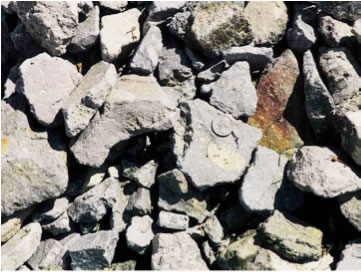Texture as an Environmental Indicator
 |
| Angular Clasts |
 |
| Rounded Clasts |
The first step in the formation of sedimentary rocks requires the deposition of sediment eroded from another location. However, in order for sediment to first be eroded and begin moving through the environment the process responsible for moving the sediment (wind, water, ice, or gravity) must have enough energy to move the individual sediment grains. If the energy decreases at anytime during over the range in which the process operates particles that can no longer be moved begin to be deposited. For this reason grain size gives some indication of the energy conditions during transport and deposition.
More specifically larger clasts require greater amounts of energy to be transported. Therefore sedimentary rocks that are composed of larger clast were mostly likely deposited in high energy environments; sand and larger clasts require vigorous currents (fast water= high energy) to be transported whereas silt and clay are transported by very weak currents and and therefore only accumulate under very low-energy conditions such as in lakes and lagoons.
As individual sediment clasts move through the environment they will interact with other clasts and rocks. As the clasts collide with other materials within the environment they become abraded and their sharp corners and edges will be worn down. The degree to which a clast has had its edges and corners worn is known as rounding. In general, the farther a clast travels within the environment the more rounded it becomes. Therefore, a sediment that contains angular clasts was most likely deposited very near to its source whereas a sediment that contains more rounded clast would most likely be deposited further from their source. Gravel transported by fast moving rivers tend to become rounded very quickly due to number of interactions with other clasts carried by the river.
 |
| Poorly Sorted Sediments |
 |
| Well Sorted Sediments |
Sorting refers to the variation in size of clasts making up sediment or sedimentary rocks. If the size range is not very great, in other words, if the sediment is composed almost entirely of either clay, silt, sand, or gravel, the sediment or rock is considered well sorted. If a sediment or rock is composed of clasts with a very wide range of clast sizes it is considered poorly sorted. Sorting results from processes that selectively transport and deposit sediments of particular sizes, which can only occur in process that undergo changes in energy. Therefore the deposition of sorted sediment only occurs in water or wind environments.
Chemical Sedimentary Rocks
Chemical sedimentary rocks are produced through precipitation of chemicals in water environments as a result of changing environmental conditions ie. temperature, pH, or oxidizing conditions. Biochemical sedimentary rocks are produced as a direct result of life processes, such as rocks composed of marine sea shells.
Since the type of material precipitated from water depends on specific environmental conditions the composition of chemical sedimentary rocks is extremely useful in revealing the environmental conditions at the time of deposition. For example, limestone which is composed of CaCO3, is deposited in warm shallow seas. If water depth is greater than 4,300 ft the temperature is too low and the pressure so high that CaCO3 actually dissolves and will not precipitate. However at these depths silica does precipitate.
Evaporites, such as rock salt and rock gypsum, are formed when water evaporates leaving the heavier dissolved chemical constituents behind. In order for this to happen temperatures have to be relatively high (to allow for evaporation) and there can little precipitation. Therefore, evaporites are typically deposited under arid environmental conditions.
Coal is a biochemical sedimentary rock that is composed of massive amounts of preserved plant material. In order for plant material to be preserved it must be deposited in environments devoid of the bacteria and oxygen that would normally cause it to be decomposed. These conditions exist only in stagnant swampy waters where abundant decomposing organic matter depletes oxygen levels which prohibits bacteria.
